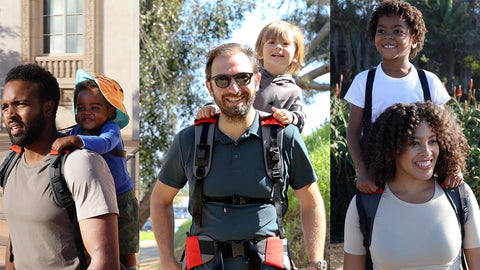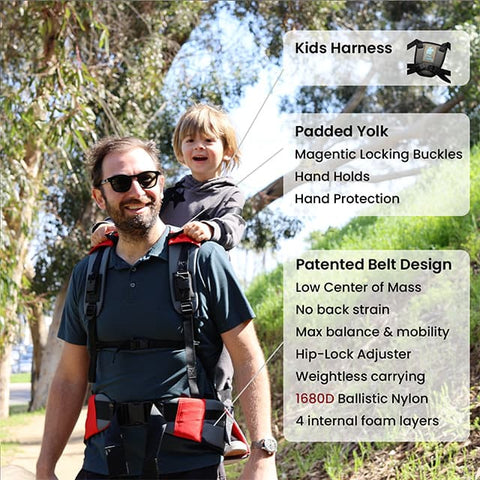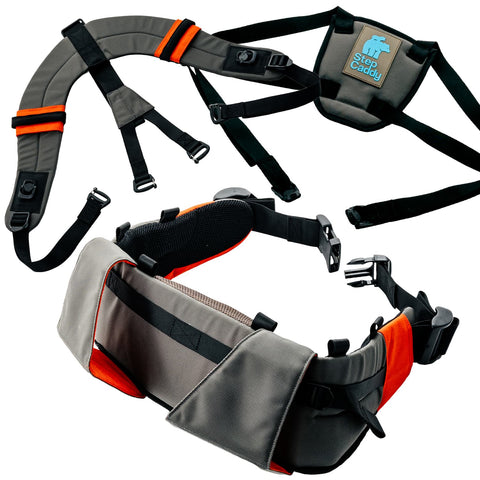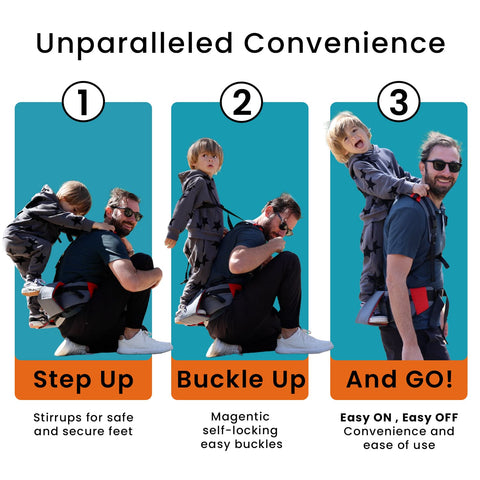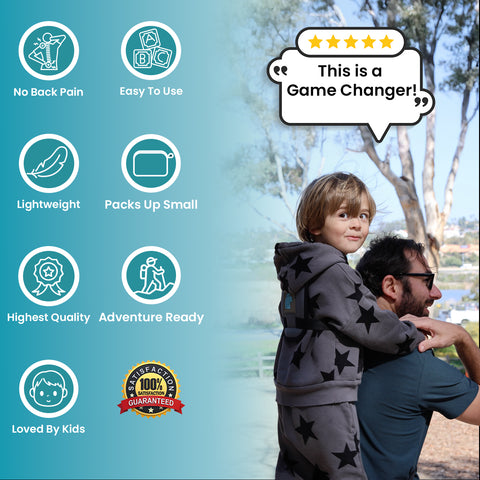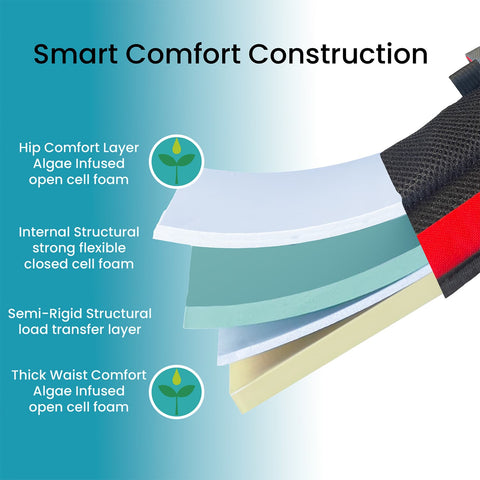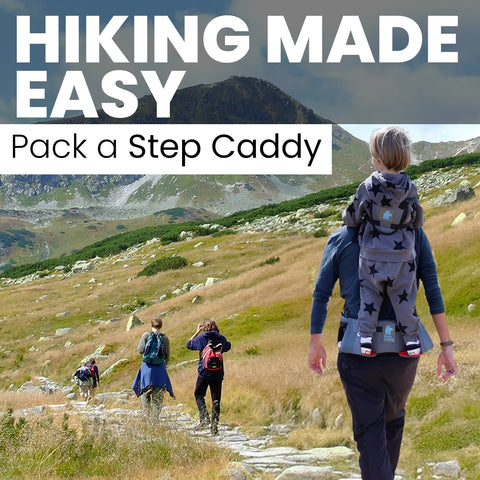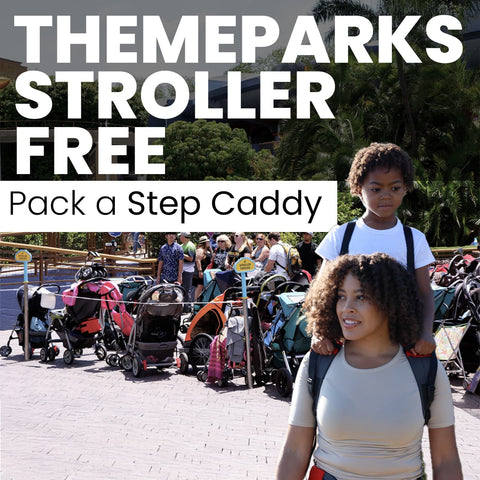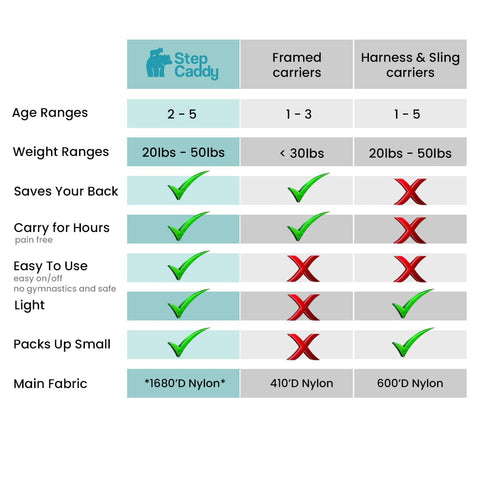Choose the Right Hiking Carrier for Young Adventurers
Heading out on a hike with a little one? Whether you're hiking with an infant, toddler, or independent preschooler, choosing the right child carrier makes all the difference for your comfort, your child’s safety, and the success of your adventure. From ergonomic backpack carriers to soft-structured slings and piggyback platforms like the Step Caddy, this guide compares the best hiking carrier options by age, terrain, and trip length. Learn what features to look for, what to avoid, and how to find a carrier that keeps you both moving with ease.
When looking at picking the right carrier for you, look at more than just the age of your child. Consider their weight and how that will affect your back, shoulders, and arms. Consider their height and how that will affect their comfort levels,packed into a sling, their legs dangling, hitting yours. Consider their energy and activity levels and the frequency of boarding and alighting. What size and age of a child favors a front carrier versus a backpack carrier or a piggyback carrier? A well-designed one keeps you and your child comfortable, allowing you to explore nature hands-free and together. This guide helps parents compare different types of child carriers, review essential safety features, ensure optimum comfort for young adventurers, and discover convenient features for parents, all while considering budget and expert advice.
Understand the Best Hiking Carriers for Preschoolers and Toddlers
Choosing a hiking carrier depends on the experience you want to share with your child. The sections below provide a brief overview of the main carrier designs and their key benefits.
Discover the Features of Framed Hiking Carriers
Big-framed child carriers are built like hiking backpacks, with a serious upgrade. They typically feature a rigid aluminum or steel frame that keeps the carrier upright when placed on the ground, making it easier to load and unload your child safely. These carriers often include padded shoulder straps, an adjustable hip belt, and a sternum strap to distribute your child’s weight evenly across your torso and hips. Many come with a built-in sunshade, storage compartments for snacks and gear, and adjustable seating positions to support growing kids. The higher seat position gives your child a clear view of the trail ahead (and behind!), while the structured frame ensures better airflow and stability for both parent and child. Designed for longer hikes, they’re ideal for parents who need robust support over rough terrain. With extra padding and adjustable straps, these carriers securely hold your child while reducing the feeling of weight, allowing for longer and more comfortable hikes. They are great for children up to the age of two, and can be used for children up to three years old, if their energy and activity levels remain low and they don't mind sitting for long periods. Big-framed carriers can be awkward getting into and out of, and are notoriously bulky.
Examine Soft-Structured Child Carriers for Convenience
Soft-structured child carriers (SSCs) are the go-to option for parents who want comfort, convenience, and a compact design without compromising on support. Unlike framed carriers, SSCs are made from flexible, padded fabric with a structured waistband and shoulder straps that buckle for a secure fit. This means weight distribution away from the shoulders and back is less effective, but these carriers are targeted at younger and lighter children, up to the age of two. Their greatest asset is that they're compact and easy to stow away and store, making them perfect for everyday use and travel. Most models support front, back, and sometimes hip carry positions, giving you flexibility as your child grows. They offer ergonomic seating that keeps your child’s hips in a healthy, "M" position, and many include sleep hoods, storage pockets, and breathable materials for hot weather. Ideal for children from infancy through to toddlers (2 years old). Without the frame, the carrier does not offer an air gap between the parent and the carrier, which can lead to uncomfortable perspiration. SSCs strike a smart balance between freedom of movement and everyday practicality.
Learn About Backpacks With Child Seats for Hiking
Backpacks with child seats are a hybrid solution that combines a standard hiking pack with a built-in perch for your little one. Unlike dedicated framed carriers, these are primarily designed for carrying gear, with the child seat added as a secondary feature. The child seating area is often more minimal, with less padding, fewer adjustment points, and limited support, making them better suited for short outings rather than long treks. That said, they’re great for casual adventures like festivals, day trips, or sightseeing, where you want to carry both your child and your essentials without switching between bags. These packs tend to be lighter and more compact than full-framed carriers, but the tradeoff is reduced ergonomic support for both parent and child.
Compare Multiple-Day Carriers for Longer Adventures
Multiple-day carriers are heavy-duty child carriers designed for extended outdoor adventures—think overnight hikes, camping trips, or backcountry treks. These carriers combine the rugged capacity of a full-sized backpacking pack with the safety and comfort features of a framed child carrier. They typically offer high-volume storage (often 30+ liters), allowing room for food, water, diapers, extra clothing, and even a sleeping bag, all while keeping your child securely supported in a padded, adjustable seat. You'll find advanced suspension systems, load lifters, breathable back panels, and highly adjustable harnesses to distribute weight efficiently over long distances. Built for endurance and versatility, multiple-day carriers are for parents who aren’t just going on a walk in the woods—they’re bringing the whole trail life with them. Engineered for extended trips, multiple-day carriers offer extra padding, built-in sunshades, and weather-resistant materials. With robust suspension systems, adjustable harnessing, and extra pockets for items like diapers or clothing, these carriers are ideal for multi-day adventures where safety and convenience are vital.
Investigate Lightweight Carriers for Easy Transport
Lightweight carriers prioritize reducing overall mass by utilizing innovative materials, such as high-strength polymers. These carriers maintain support and stability while enhancing agility on long distances. Their simplified buckling systems and minimalistic design make them easy to adjust and pack, ideal for challenging or remote terrains.
Investigate Piggyback Carriers for Preschool Kids
Piggyback-style carriers, like the Step Caddy, take a different approach to child transport by embracing your kid’s growing independence while still giving them a lift when needed. These carriers are built for older toddlers and preschoolers, typically ages 2 to 5, who can walk but tire regularly on longer outings. Instead of a full seat, they feature a standing platform or step that supports the child’s weight while keeping them safely secured with harnesses and handholds. The carrier itself is compact, lightweight, and built with back-saving features like padded shoulder straps and waist belts that shift weight to the hips. The piggyback position offers the greatest convenience of all the carriers for ease of mounting and dismounting. With a low weight transfer point and a low center of mass, Step Caddy in particular offers the best weightless carrying experience. This style of child carrier also provides the greatest ventilation of all categories, and packs up small for stowing. They’re ideal for theme parks, festivals, hikes, or any time your “big kid” wants to ride high and stay close without being confined. It’s freedom with a fallback plan, fun for them, practical for you..
Safety Features That Matter in a Hiking Carrier
Safety is paramount when choosing a hiking carrier. Modern carriers include a range of features to protect your child during outdoor adventures.
Check Stability and Base Design for Secure Seating
A sturdy, well-designed base keeps your child safely seated even on uneven terrain. For all types of carriers, you must consider where the child's weight will be centered. The higher their center of mass, the more unstable the parent. Low center of mass and low transfer points create more mobility, stability, and greater balance for the parent. When hiking on uneven terrain, this is an important safety consideration. Carriers like the Step Caddy are designed to have a lower and closer-to-your-body center of gravity, which makes the load feel lighter, more stable, and easier to carry, especially on uneven terrain. A poorly positioned center of gravity (like a high, far-back child seat) can throw off your balance and strain your back. When evaluating carriers, always consider how the design manages the center of gravity to ensure both comfort and safety.
Ensure Safety Straps and Harnesses Are Reliable
Reliable harness systems featuring multiple adjustment points and reinforced shoulder straps are essential. High-quality buckles, such as magnetic-homing self-locking types, securely fasten the child and minimize slippage even in sudden stops or rough conditions.
Review Materials Used for Both Durability and Safety
High-performance materials, such as Ballistic 1680D nylon and algae-infused foam, provide both durability and hygiene. These fabrics resist tears, abrasions, and UV damage, ensuring the child carrier lasts through frequent outdoor use while maintaining its safety standards.
Look for Sunshade Options for Protection From Elements
Integrated sunshades protect your child from harmful UV rays and keep the interior cool. Adjustable sunshades provide extra protection on sunny days or during open trails, reducing the risks of sunburn and heatstroke. For older kids who are in and out of the carrier frequently, a built-in sun-shade won't help; invest in a high-quality sun hat for your kid (and yourself).
Confirm Weight Limits to Safeguard Young Adventurers
Every child carrier comes with a recommended weight limit based on extensive testing. Ensuring your child’s weight stays within these limits helps maintain carrier integrity and optimal support.
Investigate Additional Accessories for Enhanced Safety
Additional features such as reflective strips for low-light visibility, integrated hydration systems, extra impact-resistant padding, and detachable rain covers further enhance safety. These accessories adapt the child carrier to a wide range of environments, providing extra layers of protection.
Comfort Features That Matter in a Hiking Carrier
Comfort is as important as safety. A comfortable carrier keeps your child happy and relaxed, allowing you to focus on the adventure.
Evaluate Padding and Support for Long Hikes
Quality padding in the seat and straps prevents chafing and pressure points during long hikes. Ergonomic designs using memory foam or algae-infused foam naturally adapt to your child’s shape and evenly distribute weight for lasting comfort.
Examine Ventilation Options for Warmer Days
Breathable mesh panels and strategically placed ventilation openings prevent overheating by ensuring continuous airflow. Good ventilation minimizes sweat and skin irritation, maintaining comfort even during hot summer hikes.
Assess Adjustable Features for Growing Children
Multiple adjustment points on straps, harnesses, and seating allow the child carrier to grow with your child. This adaptability ensures a secure and comfortable fit on every hike, making carriers like the Step Caddy a long-term solution.
Look for Ergonomic Designs to Prevent Discomfort
Ergonomic designs align your child’s posture naturally while reducing strain on their developing body. Features such as a contoured back panel and an adjustable seat that supports both the spine and pelvis help prevent fatigue for both child and parent.
Research User Reviews for Real-world Comfort
User feedback provides insights into long-term comfort and durability. Reviews highlight practical details such as the effectiveness of padding, ventilation, and adjustments, helping you choose a carrier that consistently scores high in comfort.
Test the Carrier Before Purchase for the Best Fit
Whenever possible, try the carrier in person. Demonstration sessions allow you to assess the fit, ease of adjustments, and ventilation, ensuring the carrier meets both your needs and those of your child.
Convenience Features That Matter in a Hiking Carrier
Aside from safety and comfort, a carrier should enhance parental convenience during hikes.
Check the Accessibility of Pockets for Storage
Easily accessible pockets help you store water bottles, snacks, maps, and personal items, keeping your hands free. Well-designed pockets ensure essentials are secure yet reachable throughout your hike.
Investigate Easy-to-Use Adjusting Mechanisms
Intuitive buckles and strap systems allow for swift adjustments on the go. Rapid adjustments reduce delays when changing gear or transitioning between trails, keeping the adventure flowing smoothly.
Review Collapsible Designs for Transport and Storage
Collapsible carriers fold into compact sizes for easy car storage or home organization. This design is particularly useful for those with limited storage space or frequent travel.
Compare Weight and Bulk for Ease of Handling
A lighter, less bulky carrier minimizes strain on parents. Advanced materials help achieve an optimal balance between durability and low weight, ensuring ease of handling during long treks.
Look for Integrated Hydration Solutions for Hydration
Some carriers include built-in hydration systems with compartments or water bottle holders, allowing quick access to fluids. This feature is invaluable on long hikes or hot days when hydration is critical.
Budget Considerations for Hiking Carriers
Balancing features with budget is key when choosing a hiking carrier. Consider both upfront costs and long-term value.
Establish a Budget Range Based on Your Needs
Determine your budget by considering how often you plan to use the carrier, the typical terrain, and the expected duration of use. A reasonable budget should prioritize essential safety and comfort features while providing long-term value.
Compare Costs of Different Types of Carriers
Framed, soft-structured, backpack-style, multi-day, convertible, and lightweight carriers come at different price points. A comparative analysis based on materials, safety features, and durability can help decide which type offers the best overall value.
Look for Discounts and Sales for Value
Seasonal discounts, flash sales, or bundle deals can make high-quality carriers more affordable. Signing up for newsletters or following retailers on social media may help you secure a good deal.
Evaluate Second-Hand Options for Budget-Friendly Deals
Gently used carriers can offer economical alternatives without compromising on quality. When buying second-hand, ensure all safety features are intact, and the carrier shows little wear.
Assess Warranty and Return Policies for Risk Management
A strong warranty and flexible return policy reflect the manufacturer’s confidence and offer peace of mind. These policies are important in case the carrier does not meet your expectations after purchase.
Consider Maintenance Costs for Longevity
Factor in any ongoing maintenance costs, such as replacing straps or padding. Carriers that offer cost-effective maintenance solutions can provide added long-term value.
Below is a comparative table outlining key budget-friendly options:
|
Carrier Type |
Price Range |
Key Features |
Estimated Maintenance Cost |
|---|---|---|---|
|
Framed Carrier |
$200 - $400 |
Rigid frame, bulky, best weight distribution, air-gap to back, poor boarding/alighting |
Low |
|
Soft-Structured Carrier |
$100 - $250 |
Lightweight, packable, flexible design, poor weight distribution, No air-gap to back, average boarding/alighting |
Minimal |
|
Backpack with Child Seat |
$250 - $450 |
Integrated storage, average weight distribution, air-gap to back, poor boarding/alighting |
Moderate |
|
Multiple-Day Carrier |
$300 - $500 |
Extra padding, weatherproof materials, heavy, best weight distribution, air-gap to back, poor boarding/alighting |
Moderate |
|
Lightweight Carrier |
$150 - $350 |
Minimalist, high-grade polymers, Lightweight, packable, flexible design, poor weight distribution, No air-gap to back, average boarding/alighting |
Low |
|
Step Caddy Carrier |
$200 |
Lightweight, packable, best weight distribution, air-gap to back, best convenience for boarding/alighting |
Minimal |
Read Customer Reviews and Expert Recommendations
Before finalizing your purchase, it is wise to consult customer reviews and expert advice. Real-world experiences can reveal the practical performance of a carrier.
Explore Reviews for Insights on Carrier Performance
Customer reviews detail aspects like comfort, ease of adjustment, and durability. Look for consistent positive themes—such as reliability of safety features—to guide your decision.
Look for Expert Advice From Seasoned Hikers
Expert reviews provide in-depth comparisons based on rigorous field tests. Trusted parenting blogs, outdoor gear sites, and professional hikers often highlight a carrier’s ergonomic design and safety performance.
Analyze Ratings for Best-Selling Carriers
High ratings and best-seller status generally indicate a popular and trusted product. Consistent five-star ratings for safety, comfort, and ease of use are strong indicators of quality.
Compare Feedback Regarding Comfort and Usability
Detailed feedback from other parents can help you understand how well a carrier accommodates various body types, handles long hikes, and remains easy to clean, ensuring it meets everyday usability needs.
Find Reputable Sources for Trustworthy Recommendations
Rely on reviews from well-established outdoor gear sites and parenting magazines. Cross-reference opinions to ensure you receive a balanced view rather than relying solely on marketing claims.
Join Forums to Gather Personal Experiences and Tips
Online discussion boards and social media groups provide a wealth of anecdotal advice. Personal interactions with other parents can offer tips on fit, maintenance, and alternative products that may better suit your specific hiking needs.
Frequently Asked Questions
Q: What safety standards should I look for in a hiking carrier? A: Look for carriers with rigorous testing, reinforced harnesses, secure buckles, and a low center of gravity. Products like the Step Caddy incorporate high-performance materials and innovative safety features that meet industry standards.
Q: How comfortable are hiking carriers for long-distance hikes? A: Many carriers offer ample padding, adjustable straps, and ergonomic support to reduce fatigue for both child and parent. Memory foam cushioning and breathable materials further enhance comfort during lengthy hikes.
Q: Can I adjust the carrier as my child grows? A: Yes, modern carriers—especially convertible designs—feature multiple adjustment points to accommodate a growing child and support both front and back carrying positions.
Q: Are lightweight carriers less durable? A: Not necessarily. Lightweight carriers use advanced composite materials that provide durability without added bulk, maintaining safety while reducing overall weight.
Q: How do integrated hydration solutions work in carriers? A: Integrated hydration features include built-in pockets or compartments for water bottles, enabling parents to quickly access fluids without removing the carrier.
Q: What maintenance is required for these carriers? A: Regular maintenance involves cleaning fabric surfaces, checking the integrity of straps and buckles, and occasionally replacing padding. Follow the manufacturer’s guidelines to ensure longevity.
Q: How can I be sure the carrier I choose fits my body type? A: Look for products with adjustable features and read user reviews regarding fit and usability. Many retailers offer trial periods or detailed sizing guides.
Q: Is the Step Caddy suitable for all types of terrain? A: Yes, the Step Caddy is engineered to handle a variety of terrains—from smooth trails to rugged paths—thanks to its low center of mass and uniform weight distribution.
Q: Where can I buy a Step Caddy? A:
🛒 Shop the Step Caddy Now
Q: Where should a backpack ride on my hips? A: Child carriers with rugged load-bearing waistbelts, like the Big Framed Carriers and the Step Caddy, have designs based on decades of backcountry backpack designs. These waistbelts have multiple layers of deliberately shaped foam designed to encompass your iliac crest bone (the hip bone). Check the instructions for your particular vendor, but it is likely that the waistbelt should be about one inch above the iliac crest bone. The Step Caddy waistbelt also has the new innovation of a Hip Lock Strap, which, when tightened, curves the waistbelt over the iliac crest bone, enhancing weight transfer and comfort.
Is the Step Caddy a Good Preschooler Carrier?
Yes, it is. So, finding the perfect hiking carrier for your young adventurer means balancing safety, comfort, convenience, and price. Understanding the differences among framed, soft-structured, backpack-style, multi-day, convertible, and lightweight carriers helps you make an informed choice. Safety features, such as stable bases, reliable harnesses, and high-quality materials, keep your child secure. Meanwhile, user-friendly adjustments, integrated storage, and hydration solutions enhance the hiking experience for both parent and child. With thoughtful research and consideration of customer and expert feedback, investing in a high-quality carrier such as the Step Caddy turns outdoor adventures into comfortable, enjoyable, and worry-free experiences, allowing you both to focus on the beauty of nature and create lasting memories.

